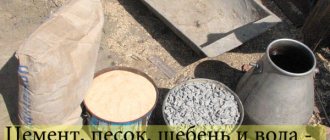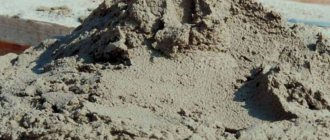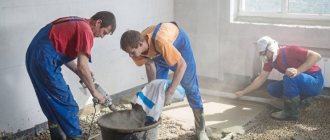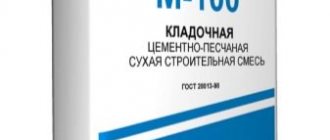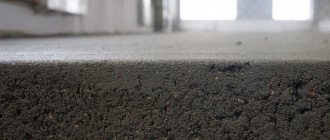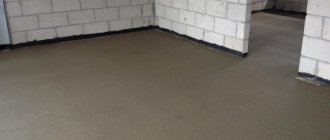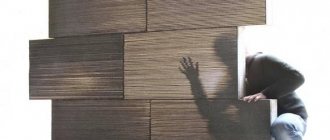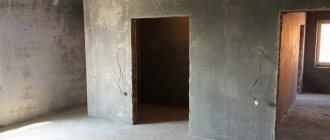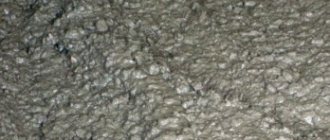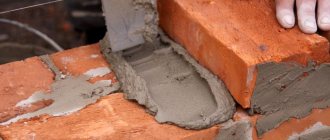When you proceed directly to the construction of any structure, then after drawing up the project you need to go shopping in search of quality materials. To perform various masonry work, concreting floors, erecting brick walls, eliminating cracks and other defects, you should use a dry cement-sand mixture. But in order to save money, it is necessary to determine in advance the required amount of building material. Here you need to calculate the mixture proportions and consumption, which, in turn, depends on the type of structure.
What is a cement-sand mixture?
For private construction work, when the use of cement-sand mixtures does not imply special responsibility, it is possible to independently prepare them using any cement and any sand. At the same time, you need to understand that due to the difficulty of maintaining exact proportions in mixtures, the finished solutions will differ in properties to a greater or lesser extent with each new batch.
Professional construction activities are carried out using standardized materials, the quality of which is guaranteed by the presence of strictly defined and uniform properties. Only industrial production can meet these requirements.
Important.
In addition to cement-sand mixtures, sand concrete is used in construction. This is another material, characterized by the presence of a filler fraction of up to 1 cm, which is too small for just concrete.
Domestic and foreign enterprises produce dry mixtures for construction, the composition and production technologies of which are regulated by GOST 28013. According to its requirements, a professional cement-sand mixture - TsPS must contain:
- high-quality sifted Portland cement grade M500 and higher;
- pure quarry or river sand with a particle size of 1.3 - 1.5 mm, which corresponds to the average fraction;
- To improve properties, mineral additives are allowed, the volume of which should not exceed 10% of the total.
The components of the mixture must correspond to: —cement; - sand. Water for preparing solutions - according to .
All technical data and conditions are indicated on the bags in which the finished DSP is packaged. Or in technical documents, when a bulk version is ordered for large-scale construction.
Depending on the area of application of the cement-sand mixture, one or another type is selected.
Types of materials and consumption ratio
Now let's look at the types of materials and their consumption:
- Mixture for floor screed in residential premises . What are the proportions of cement and sand for screed? In this case, it is necessary to use material M150 or M200. To obtain such parameters, it is necessary to take M500 cement and sand in a ratio of 1:3. You can also use M200 cement, then its ratio with sand will be 1:2. It would be very nice to place fiber fiber in the solution in an amount of 800 g per m3. The consumption in this case will be 20-21 kg/m2. Here we describe in more detail the consumption of CSP for floor screed per 1m2. One of the popular manufacturers is Vetonit:
- Plastering surfaces . To prepare the mixture, use a ratio of 1:3. The amount of material per m2 will be 17 kg.
- Wall masonry . When preparing masonry mortar, special attention must be paid to the cleanliness of the sand. If there are foreign inclusions, then it is worth sifting the material. Only then will you be able to obtain a homogeneous mass that will allow you to securely hold the bricks together. Proportions can reach 1:3 or 1:6. Consumption per m2 will be 0.05 m3. The proportions of the mortar for laying the stove are described here.
What types of cement-sand mixtures are there?
The division of cement-sand mixtures into various types is carried out according to different criteria:
- Proportional ratio of cement and sand. If the sand/cement ratio is 3:1, we have fatty mixtures that are most often used for floor screed, plaster in conditions of high humidity, and masonry mortar for mid-rise buildings. Lean mixtures are obtained by mixing sand with cement in a ratio of 5:1 - usually these are plaster mixtures for interior decoration; Often it is made even cheaper, partially - up to half - by adding lime or even clay instead of cement. Normal mixtures have intermediate proportional relationships; their use is most universal; with proper use of modifying additives, they can often replace more expensive fatty mixtures.
- Quality and quantity of binding components. The use of different types of mixtures depends not only on the percentage, but also on the brand of cement. Higher grades of cement can withstand more severe loads. In dry rooms, other binders can be used along with cement: lime, magnesium compounds, gypsum. Most often it is gypsum, which is used for special decorative coating and rapid hardening.
- The final density and strength of the hardened mass and the associated scope of application of the CPS. Hardened solutions can be light or heavy. The density of light ones does not exceed 1500 kg/m3, the density of heavy ones is more than 1500 to 1800 kg/m3. Strength is directly dependent on density, which can be considered the main characteristic of DSP, since it is the marking of mixtures by strength that determines their practical purpose. For marking, the letter “M” and a number are used, which indicates how many kilograms of static load 1 cm3 of hardened material can withstand. The DSP brand is what primarily determines its type, properties and application.
- Different price. There are expensive and cheap cement-sand mixtures on the market. And all of them are in demand, since the advantages and disadvantages are relative. In some cases, the ability to withstand physical and temperature superloads, hydrophobicity, etc. is important, while in others, low specific gravity and ease of application are important.
Table 1.
Mixtures for different purposes depending on the brand.
| Brand | Application | Peculiarities |
| M10, M25, M50 | for light plasters and finishings | contains clay, lime |
| M100 | classic interior plaster mixture | contains lime |
| M150 | laying tiles | bricks, internal and external plastering work, repair of cracks and seams indicating the connection of structural elements - the minimum strength for masonry |
| M200 | assembly masonry, high load screeds | the best combination of price and quality |
| M300 | arrangement of different types of foundations, screeds, blind areas | not suitable for plaster mortars |
| M400 | responsible construction, concreting of important load-bearing structures | high price and high hardening speed |
There are higher grades, but only for the industrial construction of particularly loaded service objects, for example, bridges.
Attention!
During large-scale construction, to ensure better strength, it is preferable to use not just a high-grade cement-sand mixture, but concrete made on its basis.
How to prepare TsPS?
Each ready-made mixture must be accompanied by instructions on the required amount of water; other components are usually not provided. When used as part of additional materials (dyes, reinforcing fibers), the proportions must be observed strictly in accordance with the instructions for the additive. The typical ratio of mixture to water is 5 to 1 (a bucket of water per 50 kg bag of mixture), the share of dyes is 0.1%, the share of fiber fiber is 1%.
When making it yourself, the proportions of water and sand to cement are taken depending on the type of work being carried out, strength requirements, and the degree of moisture content of the sand:
1. The thickest mortar required for masonry is the water/cement ratio of no more than 0.8.
2. For screed and plaster, sour cream-like compositions with a W/C ratio of 0.8–1.2 are used.
3. When spraying and grouting, dilute the solution even more, up to W/C - 1.5.
4. Mixtures with W/C less than 0.6 are used when it is necessary to obtain a quick-drying high-grade cement-sand mortar (M300 and higher), or for concrete.
If a concrete mixer is used for mixing, it is recommended to carry out the work in the following order:
- Pour water into the untwisted drum and add additives.
- Add 2 buckets of sand.
- Add a bucket of cement and wait for it to mix.
- Add the remaining sand and add water if necessary.
This technique will prevent the concrete mixer from stopping due to sand caking on one side and covering its surface with a layer of hardened cement laitance.
When kneading by hand, water is poured into the dry mixture. If you do the opposite, water forms a film of cement on the surface of small lumps of the mixture, which will slow down the process many times over. If the composition is made from its own components, it is advisable to mix them dry before adding water.
Once prepared, the solution must be used before it begins to harden - from 15 minutes to several hours, depending on the use of additives, cement concentration and temperature. The usual solution M150-M200 at a temperature of 20 ° C begins to harden an hour after mixing.
Consumption
To plan the mass of the CPS in advance, you need to approximately calculate the required volume of solution and multiply it by the cost per 1 m3 indicated in the description of the mixture. Most often they are indicated in the format “mixture consumption per m2”, meaning a layer 1 cm thick. To get the costs per 1 m3, just multiply the indicated value by 100.
The usual consumption values for sand-cement mixture are 1800 kg/m3, for high-quality compositions - up to 2200 kg/m3, for lightweight plasters with lime - 1200-1600 kg/m3.
Calculating the volume of consumption of mortar for plastering work and screed is not particularly difficult, but the cost of material for masonry depends on the skill of the particular performer. If you strictly follow the technology, the solution consumption will be 25% of the total volume of the wall, but in practice this value can be either up to 35% (thick seams, losses due to splashes) or below 20% (waste masonry, use of poor-quality techniques to speed up work ).
What are the advantages and disadvantages of cement-sand mixtures?
The advantages of different types of cement-sand mixtures have been confirmed by practical use for quite a long time. The undoubted advantages include the following properties:
The DSP also has its disadvantages:
- with a lack of construction equipment, in some cases it becomes difficult to knead or apply the mortar;
- the mixtures take a long time to dry;
- low decorative properties: unsatisfactory color, porosity.
When a certain amount of cement is replaced with gypsum to make a mixture, characteristics such as ductility, shrinkage, drying speed, weight, and decorativeness are improved. However, this reduces moisture resistance and strength, and significantly increases the price.
If we compare ready-made and self-prepared DSPs, the latter are cheaper in terms of the total cost of all components, but are significantly inferior in ease of use and quality.
The ready-made mixture has many advantages:
- strictly standardized composition, in a constant and unchanged ratio;
- best quality components: sifted cement, calibrated and cleaned sand;
- there is no need to calculate the percentage of each ingredient and make other calculations - the manufacturer has taken care of everything, and all that remains is to dilute the dry mixture with water and stir;
- on the packaging of the finished mixture you can read what work it is intended for; at the same time, it contains the additives and additives necessary for this.
Cement-sand mixture (CPS) 1:1 - 1:12, delivery and pickup
You can buy CPS (cement-sand mixture) with delivery or pickup.
The fastest way to order a central station with delivery is to call us at +7 (sales department) or +7 (construction department) (Call reception: from 8:00 to 21:00) and place your order.
In repair, construction or reconstruction, this material made from a mixture of cement and sand is indispensable due to its convenience and versatility of use. The solution prepared from it is ideal for leveling floors and walls, concrete and brick surfaces, for filling voids when laying bricks, and is used in road construction. Such multi-purpose use of CPS is ensured by its excellent properties: ease of use, strength during hardening, frost resistance. Various chemical modifiers are also added to the mixture prepared in production to improve the characteristics of the DSP. Transporting the mixture and storing it dry will also not cause you any problems. In addition, it will save effort and time, because it will not require any additional additives; you just need to carefully read the instructions, add water, stir, and the solution is ready for use!
Price of cement-sand mixture
| Cement : sand ratio | Price | Cement : sand ratio | Price |
| 1:1 | 5600 rub/m3 | 1:2 | 4200 rub/m3 |
| 1:4 | 3050 rub/m3 | 1:5 | 2800 rub/m3 |
| 1:6 | 2550 rub/m3 | 1:8 | 2300 rub/m3 |
| 1:10 | 2050 rub/m3 | 1:12 | 2050 rub/m3 |
Application for a discount
Proportions
Depending on the purpose of use, CFRP contains different proportions of sand and cement, the latter of which is necessary to ensure the strength and reliability of the construction project or cladding. For example, for indoor floor screed or masonry mortar, it is customary to dilute the material in a ratio of 1/4, and the cement-sand mixture for plastering is prepared at a rate of 1/3. There are other ratios: 1/10, 1/8, 1/6, 1/2, 1/1. Each of them differs in the degree of strength when solidified, as well as a number of other characteristics.
Price categories
There are three main groups of DSPs, varying in price. The most expensive category of mixtures contains special additives that increase its wear resistance and prevent tearing and abrasion. In addition to sand and cement, the material of the second group contains cellulose ethers, which increases the water-resistant ability of the solution (perfect for plastering or tile mortar). The last and cheapest group includes conventional CSP without additives, which, however, are popular due to their ease of preparation. Whatever category you choose, you can be sure that our cement-sand mixture is prepared using the best equipment and in compliance with all accepted standards. It is in our company that you will find the ideal ratio of price and excellent quality!
Order and delivery of DSP from any LenBeton production:
* Office LenBeton Address: Leningrad region, Novoselye settlement, from 9:00 to 18:00 (Mon-Fri) * BSU "Novoselye" 80 m³/hour
Address: Leningrad region, Novoselye settlement.
Around the clock
What do supplements provide for CSP?
So, the composition of modern cement-sand mixtures necessarily includes additives to improve their properties and to facilitate work in which a mortar prepared from them is used: plaster, masonry, floor screed and any other.
Plasticizing, antifreeze and other specialized additives
The process of hardening and strength gain for all mortars made on the basis of cement-sand mixtures, including concrete, is determined by the maturation and hardening of the binder component, that is, cement. This occurs as a result of an exothermic chemical reaction between cement and water. That is, water is added not only for plasticity and mobility, but also for the formation of solid cement stone. There are two problems associated with the use of water:
Problem one.
The optimal water-cement ratio is 0.4. That is, for every kilogram of cement you need 400 g of water. However, this is not enough for the mixture to be sufficiently mobile. If you increase the proportion of water, the quality of the hardened mixture will subsequently be worse. And this is where an additive such as a plasticizer comes to the rescue: it increases the fluidity of the cement mortar several times without adding excess water and maintains it in working condition for a long time.
Problem two.
At normal temperatures, the initial stage of hardening of the solution - setting - requires only 2-3 hours. As the temperature decreases, the hardening process gradually slows down. At zero value, setting occurs after 15-20 hours, and with further cooling, when the heat released as a result of the reaction is not enough and the water eventually freezes, the process of strength gain stops. The best solution to the problem is an antifreeze additive. Its operating principle is a significant reduction in the freezing point of water. It also works as a strength gain accelerator.
In addition to solving underlying problems, supplements can help improve health benefits such as:
- Increasing the water repellency of CFRP and concrete—a waterproofing additive.
- Strengthening mechanical strength is a highly effective fiber additive - fiber, which contains thin steel, glass, basalt or polypropylene fiber. When kneading, the fiber is easily distributed throughout the mixture. In the production of polymer fibers, special impregnation is used to stimulate this property.
Complex Supplements
Recently, thanks to the successful development of chemical science and production, fundamentally new additives for cement mixtures have appeared. They are distinguished by increased efficiency, expanded functionality, and universal application. And also ease of use - it is much easier when, instead of a set of products with different properties, one multifunctional complex additive is used. For a clear example of versatility, we present a table with data on some GOODHIM products.
Table 2.
Additives for concrete and CFRP produced by GOODHIM enterprises.
| The product's name | Properties |
| Superplasticizer INTERPLAST AT | Increasing the mobility of mixtures, saving cement - 15%, frost resistance and water resistance during operation. |
| FROST PREMIUM, anti-frost additive with plasticizer | Strength gain at low temperatures, down to -25 degrees, possibly up to 30% at one day of age; 3-4 times increase in fluidity with a decrease in water content by 15%. |
| FROST XKM -25.5, antifreeze additive | Hardening at negative temperatures, up to -25 degrees; accelerated strength gain, reduction of setting time by 3 times; long-term preservation of mixture mobility; cement savings - 10%; water saving - 5-10%; increase in operational strength by 10-15%; increasing the grade of cement. |
| INTERPLAST AT S GIDRO, hydrophobic additive | Hydrophobization and reduction of capillary suction, increased workability, antiseptic properties, minimization of efflorescence. |
| FIBRA fiberglass | Increased strength, wear resistance, frost resistance, elasticity, water resistance, resistance to aggressive environments; prevention of cracking and delamination. |
| Plasticizer INTERPLAST R, summer additive | Maintains workability for 24 hours, increases air entrainment, enhances adhesion. |
| Plasticizer FROST TF R, winter additive | 30% strength gain at negative temperatures, up to -15 degrees; increased air entrainment by 10-12%; increased mobility and long life of the solution; high adhesion; prevention of delamination and efflorescence. |
Recommendations and rules
No construction is complete without at least minimal deviations from the rules. And a perfectly balanced construction cement mixture is extremely rare, as well as a perfectly prepared mortar from it. The preservation of the mobility of the mixture, as well as the process of its hardening and other properties, is influenced not only by the quality of the materials, but also by external, constantly changing factors - humidity, temperature, wind, precipitation.
The following useful facts are known:
- excess water leads to the formation of cracks;
- many of the shortcomings of the mixtures can be corrected if a higher grade of cement is used;
- The older the cement, the more of it is needed to prepare the solution.
There are some useful tips:
- When calculating the consumption of materials for preparing the total amount of solution, it is advisable to increase the final result by at least 10% - to account for unforeseen errors.
- In practice, when composing mixtures and mixing a solution, you need to take into account not only standard calculations, but also a variety of possibilities and the opinion of experienced professionals who know not only how to do it, but also how to correct mistakes.
It can be concluded that the use of cement-sand mortars for construction and repair work is associated with many inaccuracies, which confirms the advisability of using ready-made CSPs that have the most accurately calculated and measured composition.
Features of do-it-yourself kneading
The situation is much more complicated with self-mixing solutions. It uses cement purchased at the nearest hardware store and sand, the quality of which is also questionable. Factories producing building mixtures obtain ingredients for their products from regular suppliers. They use cement of a precisely known brand, without impurities and in a perfectly dry state. Sand either comes already purified or undergoes several stages of cleaning at the factory.
If you have chosen a reliable cement manufacturer and are confident in the quality of its products, then in any case sand remains an issue. The grade of the finished solution will be affected not only by the grain size of the sand, but also by its moisture content. In principle, it is possible to measure these indicators on a construction site, but this procedure is not always done. Thus, the resulting liquid mixture cannot be confidently attributed to one or another strength grade.
Based on this, in practice it was found that even strict adherence to GOST standards does not guarantee results. You should always focus on objective indicators, the main one of which is the actual consistency of the solution. The proportions of cement and sand in the composition of the cement paste can be determined with a certain accuracy, and the amount of required water is selected individually at the site of production of the solution.
Cement-sand waterproofing
Cement-sand waterproofing is the simplest type of waterproofing. It is applied by spraying or manually. When using the manual method, special additives are used. The mixture is applied in layers no thicker than 1 cm. The final thickness should be at least 2.5 cm. After drying for 2 weeks, the coating is moistened several times a day.
Attention!
Construction of cement-sand waterproofing is possible only on hard, stable surfaces in seismically stable locations.
When latex is added, the waterproofing DSP becomes plastic - it looks like liquid rubber and resembles it in properties. Apply when heated until very hot. It is most often used for arranging seamless roofing.
By adding liquid glass, a building finishing fireproof material or repair mixture with high adhesion is obtained. It is used to protect foundations and basement floors, and emergency liquidation of leaks.
To waterproof concrete surfaces, thicker compounds are used. A dry cement mixture with quartz sand and additives is diluted to a paste and applied with a hard brush to the concrete in 2-3 layers. The layers are thinner - up to 2 mm.
With the help of cement-mineral coating waterproofing, critical concrete surfaces are protected. Its disadvantage is the lack of elasticity.
A more universal coating material for waterproofing is cement-polymer coating, which includes rubber elasticizers. With the help of this thin-layer coating, not only a waterproof layer is formed, but also small cracks are blocked.
Quick answers
Special additives - plasticizers - strengthen the cement mortar. By increasing elasticity, they prevent the formation of cracks. Also, reinforcing fibrous additives such as fiber are used to strengthen solutions.
0.4 - 0.5 parts of water are added per unit of mixture. First, the mixture is poured into the container, then water is poured into the recess. Kneading is done first with your hands, then with the help of a tool. Always read the instructions for the finished mixture - the mixing option there may differ from the average.
In its natural form, river sand is preferable, since it does not contain clay impurities that reduce the strength, which are present in quarry sand. Another thing is alluvial sand, that is, high-quality quarry sand - this is the best option for the best quality screed.
Gypsum can be used as a binder. But only for dry interior spaces. Gypsum mixtures look more beautiful, weigh lighter, and form smooth surfaces that do not need to be plastered. But they are less durable and absorb moisture well.
The length and width of the floor are measured. The area is located. Multiplied by the required screed height. The resulting volume is multiplied by the density of the mixture indicated in the technical description or by the calculated one. An approximate calculation is carried out through bulk density, which is approximately the same for dry sand and dry cement. Add 10-15% of the total weight for random losses.
Compositions of dry construction mixtures (cement PC500:sand)
- M150 1:3
- M200 1:2.4
- M300 1:1.8
Bulk density of cement: 1300 kg/m3
Bulk density of sand fraction 0.8-2.0 mm 1500 kg/m3
It is easy to calculate the bulk density of the finished dry mixture:
- M150 – 1450kg/m3
- M200 – 1440kg/m3
- M300 – 1428 kg/m3
When making calculations, it is necessary to take into account that the denser the dry mixture, the smaller its volume. To determine the volume of a sand concrete bag of 50 kg, 40 kg, 25 kg in cubic meters, the weight of the bag should be divided by the density indicator.
